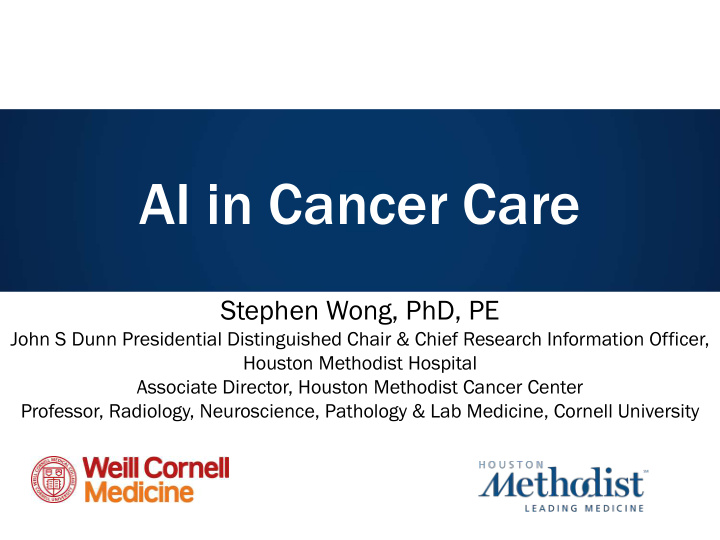



AI in Cancer Care Stephen Wong, PhD, PE John S Dunn Presidential Distinguished Chair & Chief Research Information Officer, Houston Methodist Hospital Associate Director, Houston Methodist Cancer Center Professor, Radiology, Neuroscience, Pathology & Lab Medicine, Cornell University
Disruption i in H Healthcare Macro-economics: Value-based Care, Drug Pricing, High Costs and Low Quality Interoperability, HRRP, CMS waiver, Payment Reform Accelerate the pace of healthcare transformation Waste costs the U.S. healthcare system $760B to $935B annually Sources : Socio-economics: Patients as IOM Report : Best Care at Consumers, Chronic Care Lower Cost, 2010 JAMA Network, Oct 2019 Management, Social Determinants of OECD Health Statistics . Health, Population Health, Patient- Centers for Medicare and Physician Engagement Medicaid Services, USA
Wastes in U.S. Healthcare System Estimated ranges of total annual cost of waste in the U.S. Health Care system: • Administrative complexity: $265.6 billion • Pricing failure: $230.7 billion - $240.5 billion • Failure of care: $102.4 billion - $165.7 billion • Overtreatment: $75.7 billion - $101.2 billion • Fraud and abuse: $58.5 billion - $83.9 billion • Failure of care coordination: $27.2 billion - $78.2 billion Shrank WH, et al. JAMA Network, Oct 7 2019
Case Study I: Breast Cancer Risk Assessment • ~24 million mammograms done annually in the U.S. • ~266,600 new cases of invasive breast cancer diagnosed in U.S. annually in the U.S. • False positive rate from mammogram is estimated to be 7% 7%~1 ~10% 0%. 1 • 55%–85% of breast biopsies showed benign lesions for BI-RADS 4 (2-95% 95% chance of malignancy ). ). • False positive mammograms is estimated to cost ~ $4 b billion an annual nually. 2 • Patients who have received false-positive diagnoses have shown to exhibit a higher level of anxiety and lower level of self-esteem . 1. https://www.cancer.gov/types/breast/hp/breast-screening-pdq 2. https://www.healthaffairs.org/doi/full/10.1377/hlthaff.2014.1087
Intelligence-augmented Breast Cancer Risk Calculator (iBRISK) AI augmented breast cancer • risk calculator on the cloud. Remote upload on images (or • image features) and clinical- demographic parameters. Show clinicians the list of all • the inputs as a means of garnering trust in the AI black box
iBRISK Technical Architecture Convergent AI includes EMR PACS natural language processing, image analysis, deep learning, and data mining on big multi-modal BI-RADS patient data. Free Text Reports Mammography Ultrasound Natural Language Image Analysis Processing (NLP) Clinical Signatures & Patient Breast Image Features History/Demographics Online iBRISK Calculator Imagomics Database Deep Learning Risk Assessment Model Patel TJ, et. al, Cancer 2017 Jan 1;123(1):114-121 He T, et. al, JCO Clinical Cancer Inform. 2019 May;3:1-12
Retrospective Study Results Current Dataset >14,000 BI-RADS 4 patient case data Pathology Findings Category II No. Category I (Benign) (Malignant) Subjects Benign Atypia LCIS DCIS Carcinoma 11,428 7,967 518 69 1,061 1,813 Validation datasets 2,285 cases 764 cases
Multi-center Study Results Number o of c f cases i in t three d different t types o of m f medical i institutions Institution Pathologica Pa cal Houston Methodist MD Anderson U Texas San Antonio Total Fi Finding Be Benig ign 1710 (74.84%) 1019 (71.56%) 240 (67.42%) 2969 Mali Ma ligna nant nt 575 (25.16%) 405 (28.44%) 116 (32.58%) 1096 To Total 2285 2285 1424 14 356 356 4065 4065 Houston M Methodist C Cancer C Center MD A Anderson C Cancer C Center U T Texas S San A Antonio C Cancer C Center Missing Value Rate: 13.3 .30% Missing Value Rate: 17.7 .78% Missing Value Rate: 16.0 .03% Actual Actual Actual Predicted Predicted Predicted malignant malignant malignant Sensitivity: Sensitivity: Sensitivity: malignant malignant malignant cases: 100% cases: 100% cases: 99% cases: 575 cases: 405 cases: 115 575 405 116 Actual Predicted Actual Predicted Actual Predicted benign benign benign benign benign benign Specificity: Specificity: Specificity: cases: cases: 71% cases: cases: 68% cases: cases: 77% 1710 1406 1019 695 240 184 In collaboration with MD Anderson Cancer Center and U Texas San Antonio Cancer Center Unpublished data
Case Study 2: Failure of Cancer Care Coordination connect.curaspan.com
Silver Tsunami of Cancer Survivors Estimated cancer prevalence by age in the US population from 1975 (216 M) to 2040 (380 M) Bluethmann SM, et. al, Cancer Epidemiology, Biomarkers & Prevention, 2016 Jul;25(7):1029-36.
Digital Therapeutics and Cancer Care Coordination App MO MOCHA A (Methodist Hospital Cancer Health App) Designed together with HM cancer center with behavior economics and clinical workflow to improve cancer patient survival and provide digital therapeutics R. Stubbins, et. al, JCO Clinical Cancer Inform. 2018 Dec;2:1-11.
Post Hospitalization Cancer Care Coordination using MOCHA Clinical trial on ~40 Breast cancer survivors with a body mass index (BMI) over 25 At least 6 months post active treatment (surgery, chemotherapy, or radiation). Correlation of weight change & average Summary of MOCHA use, weight loss, and SUS score daily use of MOCHA 5 3 r=- 1 0.399 -1 0 5 10 15 -3 -5 -7 -9 Post-study survey questions T. He, R. Stubbins, et al. ACO Clinical Cancer Informatics, Dec, 2018
Personalized Music Therapy + Digital Therapeutics Hypothesis: : Use of personalized music therapy treatment supplemented with digital therapeutics to improve mental health symptoms and behaviors in cancer patients and survivors. • MT-BC identify depression/ stress behaviors & symptoms Recruit cancer patients and survivors
Recommend
More recommend